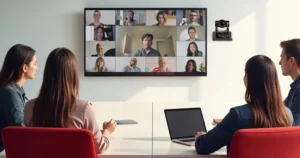Advantages and disadvantages of videoconferencing
Videoconferencing has become one of the pillars of business communication today. Therefore, in this article we will explore the advantages and disadvantages of videoconferencing and explain why it is essential to have good audiovisual equipment to carry them out.
Advantages of videoconferencing
In an increasingly globalized world, physical distances are blurring thanks to technology. And videoconferencing has become an essential tool for connecting with people anywhere on the planet, breaking down geographical barriers and facilitating communication and collaboration.
The main advantages that videoconferencing offers to companies or businesses are the following:
- Reducing geographic barriers: Video conferencing eliminates geographic limitations, allowing companies to extend their reach and collaborate with customers, partners and colleagues anywhere in the world
- Improved productivity: By avoiding the need to travel for face-to-face meetings, videoconferencing helps optimize time and increase team productivity.
- Improved communication and collaboration, especially among remote teams who find it more difficult to connect with others. With video conferencing, they can see their colleagues, share documents and collaborate in real time.
- Improved customer service: More and more companies are opting to offer video calls in contact centers, as it generates a greater degree of trust and empathy with the customer; and also for support or technical incidents, as it facilitates problem solving, by being able to share screens or documents directly with customers.
- Flexibility: videoconferencing technology can be used to organize all kinds of sessions, from team, company or customer meetings, to presentations, webinars, demos, interviews, events... It also allows connecting a large number of people in the same session in a much easier way than if they had to meet face-to-face.
- Possibility of recording: Video conferences can be recorded for future reference or to share with others who were unable to attend the session. It is always appropriate to inform participants that we will be recording the video call.
Disadvantages of videoconferencing
Videoconferencing also presents some drawbacks and challenges that are worth knowing about in order to know how to deal with and manage them.
- Technical problems: All the people participating in the videoconference must have a stable and sufficiently fast internet connection. And if there is a hardware, software or connection issue, not everyone knows how to solve it in time, generating frustration and even not being able to participate in the meeting.
- Lack of personal interaction: Interacting in person is a very complete and enriching experience that is not achieved with videoconferencing. We also lose the non-verbal signals that we transmit with our body.
- Virtual meeting fatigue: Too many virtual meetings and calls cause mental exhaustion and fatigue in many people, leading them to lose concentration and neglect meetings.
- External distractions: During videoconferences, it is easier for participants to become distracted, mentally disconnected, or to perform other tasks while in the meeting, which can make meetings less productive.
The importance of good audiovisual equipment for videoconferences
Professional-quality audiovisual equipment can help companies minimize the disadvantages of video conferencing and make it as similar as possible to face-to-face meetings, because the better the broadcast, the better the user experience .
External cameras, as opposed to those integrated into laptops, offer numerous benefits to the people attending videoconferences and, especially, to the speakers. For example:
- Better image quality: their minimum resolution is 1080p (Full HD) and, increasingly, they offer 2160p (Ultra HD or 4k).
- Better sound
- Larger field of vision
- Automatic light adjustment in low light conditions
- Autofocus, with AI tracking




